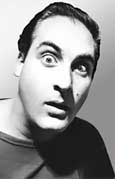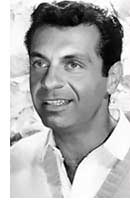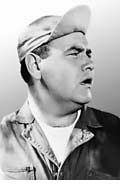Laughing Stock of the Mid-Century - Page 3
Although few of the gifted mid-century comics would ever make as much money as did Freberg, who was amply rewarded for introducing comedy to advertising copy, some went on to work in movies in the following decades, the greatest successes falling to former Sid Caesar scribes Woody Allen and Mel Brooks. A few mid-century veterans, including Shelley Berman, are still getting booked alongside the younger generations of stand-ups, for whom they made it safe to improvise, analyze, and criticize.

CRACK CUTUPS
From the bounty of funny folk on the cutting edge who kept us in stitches into the second half of the 20th century, we've singled out a baker's dozen of some of the best, most meaningful, and most memorable.
1. SID CAESAR
 His hugely popular TV show never required him to improvise or be himself, but Sid Caesar was very good at watching and listening to other people and then making a show out of it. "When I was a kid," he says, "my father had a restaurant in Yonkers, New York, a very blue-collar town with a lot of Pollacks, Russians, Irishmen, and Germans who used to come in and eat and talk, so I listened to 'em. You have to be there at the right place at the right time."
His hugely popular TV show never required him to improvise or be himself, but Sid Caesar was very good at watching and listening to other people and then making a show out of it. "When I was a kid," he says, "my father had a restaurant in Yonkers, New York, a very blue-collar town with a lot of Pollacks, Russians, Irishmen, and Germans who used to come in and eat and talk, so I listened to 'em. You have to be there at the right place at the right time."
Caesar was at the right place again, during the infancy of television in 1950, where he was able to showcase his madcap gift for mimicry to an audience that would number millions, on 'Your Show of Shows.' He had plenty of help, from his primary sketch partners Imogene Coca and later Nanette Fabray and supporting players such as Carl Reiner, as well as from a precocious writing staff.
An energetic entertainer but never really an actor or a stand-up, Caesar had no secure fallback after Caesar's Hour, the successor to his original show, ended in 1957. But he managed the occasional appearance on TV and film until he and Coca were able to mount a nostalgic comeback in the late '80s.
2. MORT SAHL

Drawn to the early 1950s intellectuals at the University of California at Berkeley by his girlfriend and first-wife-to-be Sue Babior, Mort Sahl developed a groundbreaking comedy act across the Bay at North Beach's hungry i club, channeling the cognoscenti but also poking fun at them and at the conformist, trendy, authoritarian society that surrounded them. It was more like commentary than it was a joke fest or any other kind of performance, but Sahl might be called the first of the new stand-ups to succeed in a club setting.
Saul's hungry i booking lasted a year, and he extended his success to Chicago and New York (where he impressed a teenaged Woody Allen) and to the recording industry. His national fame was certified by a cover story in Time magazine in 1960, but over the following decades Sahl's personal independence and quirkiness made it difficult to sustain his popularity. He worked as a scriptwriter and college teacher, and recently returned to the stand-up mike, stimulating the nostalgia of old fans and the curiosity of the latest generation of intellectuals.
3. JONATHAN WINTERS
 Although he's been cited as a touchstone by generations of younger comedians, most notably Robin Williams, Jonathan Winters achieved a level of energetic and brilliant wackiness well beyond the reach of most mortals. He managed, however, to market it successfully on club stages and recordings in the '60s, mainly on the strength of his impersonations of the older generation of Midwestern Americans with whom he'd grown up. A favorite among his characters was the rambunctious senior female Maudie Frickett, who, like Winters himself, was beyond pigeonholing in any place or period.
Although he's been cited as a touchstone by generations of younger comedians, most notably Robin Williams, Jonathan Winters achieved a level of energetic and brilliant wackiness well beyond the reach of most mortals. He managed, however, to market it successfully on club stages and recordings in the '60s, mainly on the strength of his impersonations of the older generation of Midwestern Americans with whom he'd grown up. A favorite among his characters was the rambunctious senior female Maudie Frickett, who, like Winters himself, was beyond pigeonholing in any place or period.
In his native Ohio, Winters studied art, but his knack for humor got him onto radio, and then on to the comedy showcase clubs of New York City. In turn, he was booked for national TV appearances while further developing his ear for rib-tickling speech patterns and sound effects, and his eye for quirky mannerisms. He pumped out this blend as high-octane free association. Winters' personal eccentricities sometimes kept bookers at a cautious distance, but his respect among peers has returned him repeatedly to the small and big screens.
4. LUCILLE BALL




